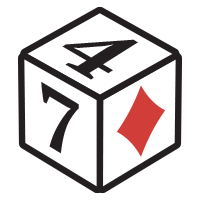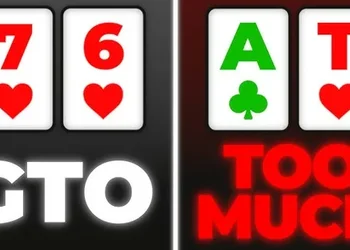You know that annoyingly good, constantly winning reg in your local card room who always seems to run you over, who applies aggression in almost every pot, and yet somehow always shows up with it the moment you take a stand. There is no voodoo here. This player is using a good exploitative strategy against the pool. But because their strategy is exploitative, a counter-strategy exists, and you can deploy it. Your opponent is playing rock; I’m going to show you how to play paper and turn the tide.
Not only will you increase your win rate by implementing these five tips, but you’ll also start to feel like the top dog. You’ll sit there secretly exploiting the reg who used to exploit you. The victim becomes the bully.

#1: Bluff Catch When Your Range Looks Weak
The first thing you can do to completely shift the dynamic against this annoying reg opponent is to start calling down with bluff-catchers in spots where your range looks weak. This type of player is running you over in situations where you look down at second pair, a pocket pair, or a weak top pair on a messy runout and simply shrug-fold. They know you fast-play too many of your good hands. They know you don’t think about relative hand strength — only absolute hand strength — and that you fold too often when your hand “isn’t that good.”
Because you’re playing the two-card game of No Limit Hold’em, your relative hand strength is often far higher than your absolute hand strength.
Your absolute hand strength will very often be one pair — sometimes third pair or second pair — but relative to their range, that one pair can actually be strong, especially against someone who over-bluffs in spots where your range appears weak.
Let’s set the scene. You are in the straddle — not the ninth straddle because everyone is stuck and trying to gamble it back — just the normal straddle. The aggressive reg opens from the lowjack. The cutoff, a recreational player who helps make the game beatable, calls. You defend the straddle with , a perfectly fine and profitable defend as long as you don’t butcher the hand postflop.
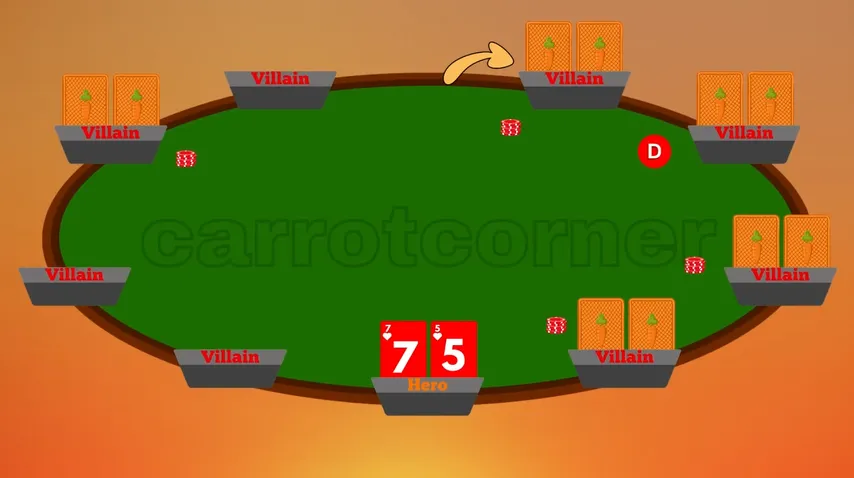
You go three-way to the flop.
The flop comes . You don’t have any backdoor flush draw, but you have second pair.
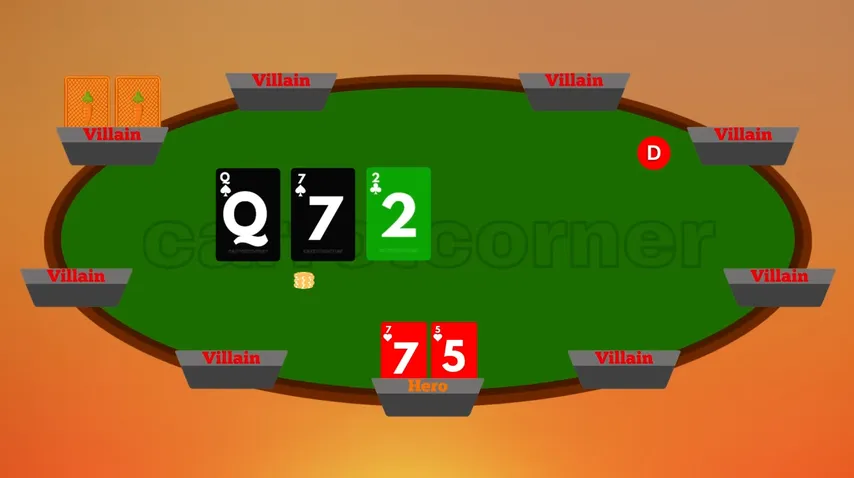
- You check.
- The preflop raiser bets one-third pot.
- The recreational player folds.
- You call.
You’re getting about 4:1 with second pair in a three-way pot, and this is a standard continue.
The turn is a . You check. Your opponent now sizes up to a big bet — something around 75% pot. You look down at your hand, think about the second overcard pairing the board, and your instinct is “I can’t call. I only have third pair.” It feels like a fishy call. It feels like what stations do when they’re stuck or what that recreational guy does after too many Cosmopolitans.
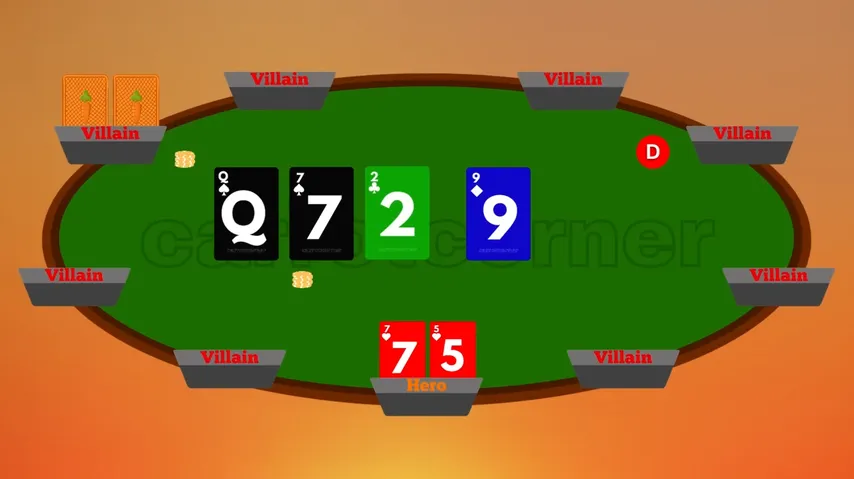
But the correct play is to call. Your third pair is an indifferent bluff-catcher in theory, and this is where having theory knowledge helps enormously.
It’s about understanding both the kind of hand you have and the range your opponent is representing. When you have a baseline from theory, you can compare what the solver expects in this spot versus what this particular reg is actually doing. That gap is where the exploit lives.
If you’ve studied this type of turn situation in theory — and this is exactly why it helps to have structured material — you’ll know that hands like second pair or third pair with live redraws are five-out draws. You have two outs to trips and three outs to two pair, and almost all of those are very clean. The and here are extremely live cards.
If the river is a , your opponent keeps value-betting overpairs, ace-queen, king-queen, and sometimes even their bluffs, because that card should not scare them. They don’t expect you to be calling the turn with much .
If the river is a , it’s an incredibly disguised two pair. You’re essentially the sniper in the bushes. They will never see that card improving you in a meaningful way. They’ll value-bet again, they’ll bluff again, and when you check, you simply call and collect.
Even when the river is a total brick — something like a — the aggressive reg is still defaulting to attacking you. You’re a straddle caller with tons of one-pair, pocket-pair, and weak-pair holdings. Their entire strategy is built around that assumption. They expect you to fold these hands, so they keep firing. All the , , , , suited, and whatever other air they opened preflop now gets blasted through the turn and river.
Your job is simple: stop letting them do it. Start calling them down in these exact spots. If this is the player who never takes their foot off the gas, you don’t need king-queen to call. You don’t need the Helmuthian fantasy of flopping two pair to “trap” them. You can simply be a real poker player with a real bluff-catcher.
You have a redraw. You have odds. You beat all their bluffs. And because they are over-bluffing these exact spots, your call becomes profitable by a mile. When you call the river for a pot-sized bet, you need to win one-third of the time to break even. Many of these aggressive regs are bluffing well above that frequency in these weak-range nodes.
#2: Bluff Unexpectedly & Scarily
The second method for beating the aggro reg is to bluff them unexpectedly and in ways that create pressure they aren’t comfortable with. Let’s take another scenario from the straddle.
This time it opens UTG+1, UTG+2 calls, the small blind calls, the big blind folds, and you call in the straddle. Four players see the flop. Your hand is . The flop is rainbow.
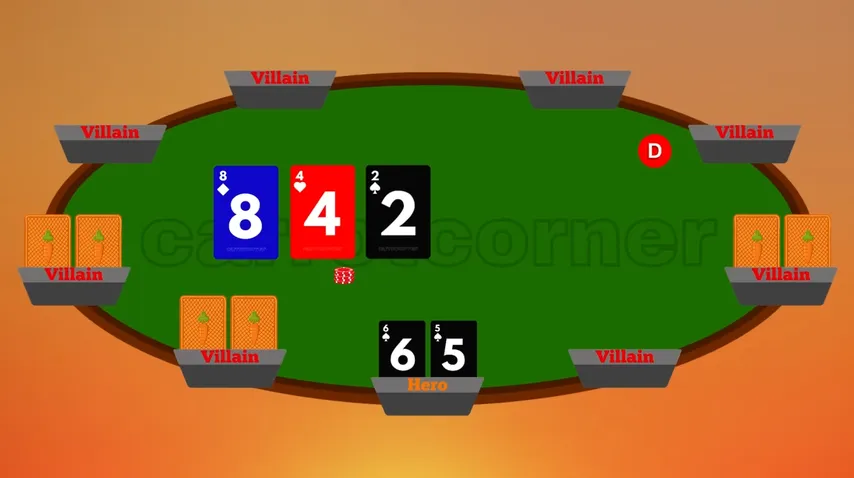
The aggressive reg continuation-bets half-pot. A recreational player snap-calls with quick timing, telegraphing medium-strength interest.
This is your bluffing window.
You raise. With you have a backdoor flush draw and a double gutter — essentially a fantastic semi-bluff hand. When you raise here, you are representing sets and the occasional trap hand like suited. Against that raise, the aggro reg is not folding an overpair, but they will fold their , , , and air combos immediately. The recreational player, who called quickly on the flop with a marginal pair, usually just folds now.
When the reg continues, they often have an overpair or some sticky underpair.
And when the turn card comes and you pick up middle pair — you are now in a very interesting spot.
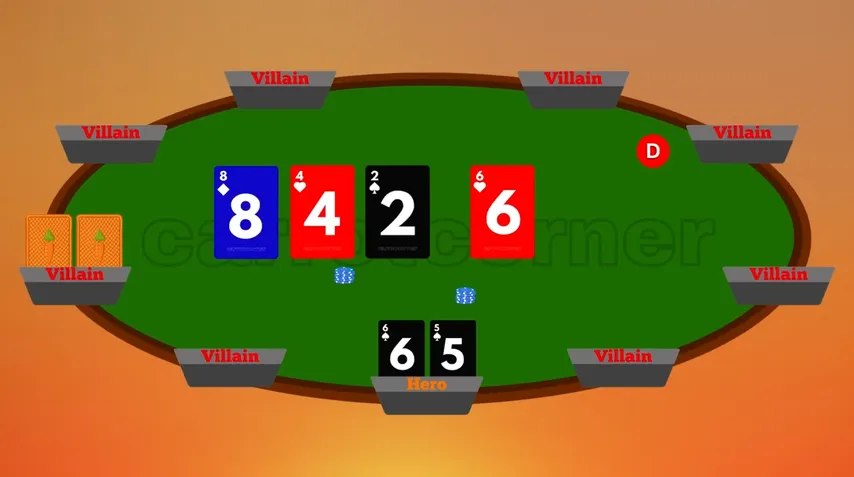
This texture is a nightmare for overpairs like . Picture the reg holding in a four-way pot after being check-raised by the straddle. Your range contains all the small sets, all the two-pair combos, and even the straight draws. Their absolute hand strength collapses. They’re suddenly holding a hand that loses to dozens of value hands you credibly represent.
When you fire a pot-sized turn bet — or a small overbet, or even a big underbet — the exact sizing matters less than the pressure. Against a strong, observant reg, pocket jacks will fold here. And you might doubt that because live pools often contain players who cling to overpairs. But this player is not one of those. A winning, aggressive reg folds overpairs when their hand becomes a pure bluff-catcher against a range that heavily smashes the board.
On , after facing a flop raise and a heavy turn barrel, their overpairs are trash, and they know it. What they don’t know is that you know that. They assume you aren't capable of pulling the trigger here without value. They assume you don’t recognize that their overpairs are in terrible shape. They assume you’ll only raise the flop and blast the turn with straights, sets, and two pair.
And that’s why your semi-bluffs print. You don’t even need a hand as strong as . That was a generous example. You can do this with a naked gutshot on many textures. The key is the line: raise the flop from an unexpected position, fire the turn big, and tell a coherent value story. It catches tough regs completely by surprise.
A leopard doesn’t change its spots unless it’s sitting on the savannah watching Carrot Corner videos on a portable TV. That’s the only time it becomes a carrot instead.

#3. Increase the Strength of Your Check-Back Range
The third adjustment is recognizing when the aggro reg is attacking weakness in your range. For example, imagine you open UTG, the big blind calls, and the flop comes all diamonds.
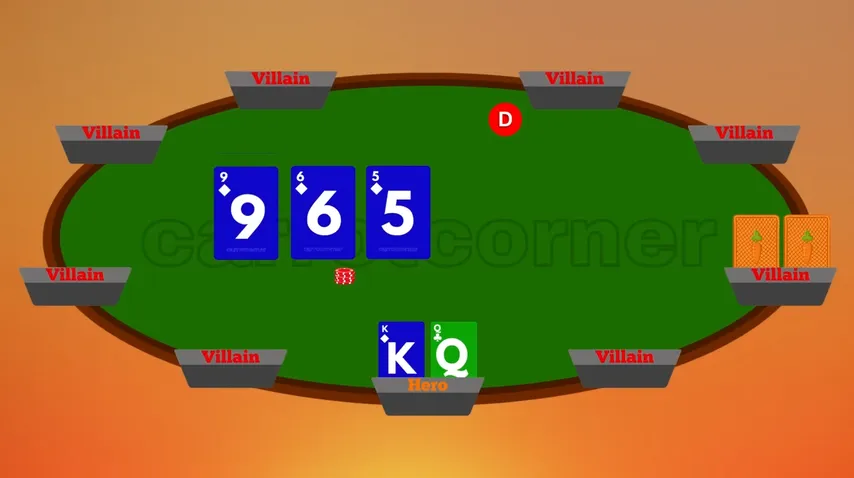
This is one of the worst flops for your UTG range. They check to you, and you check back. The turn is the . They lead half-pot. You call with something like king-queen with one diamond. The river pairs with a , and they fire two-thirds pot.
You shrug and fold.
Nothing dramatic seems to have happened — but you actually got crushed.

Why? Because you aren’t studied enough in theory. You haven’t internalized that monotone is atrocious for your opening range and amazing for theirs. You’re supposed to protect your check-back range with strong hands — even flushes. A solver checks back flushes on this flop at some frequency. It checks back sets. It checks back some two-pair. All for structural reasons related to board coverage, equity distribution, and pot control.
When you never check back strong hands here, your range becomes extremely fragile. Then when the turn bricks, the big blind is supposed to probe aggressively — with bluffs, thin value, and protection bets. Their lead frequency is high. Your range is unprotected. They take advantage. They double-barrel rivers. And because your check-back range is too capped, you fold everything except the top of range — which you don’t even have in that line.
To fix this: Start inserting real hands into your flop check-back range specifically against these aggressive players. Don’t let the spot be automatically weak in your range. Keep flushes, strong two-pair, and sets in your checking line. Now the turn lead becomes far less profitable for them. They can't just auto-print by mashing the bet button on every brick river.
For example, say you have . You flop the nut flush. They check, you check. You feel like you're missing value — but you're not.
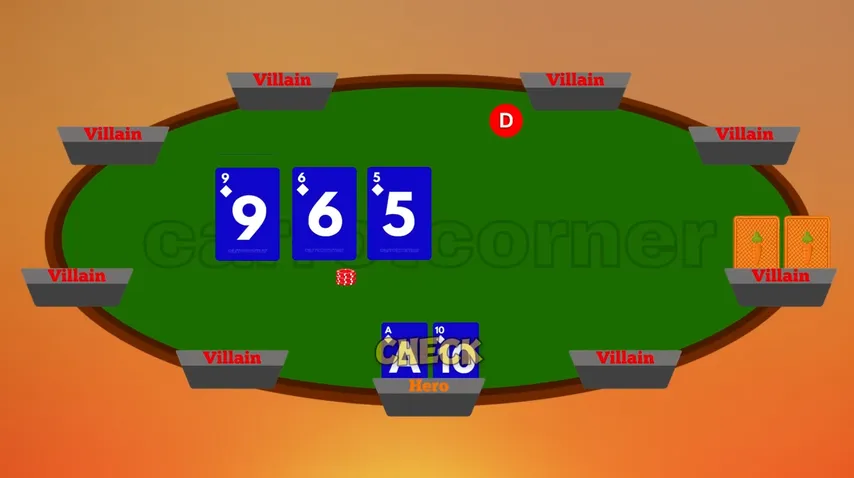
They will never call down with one pair on monotone if you triple barrel. Checking back disguises your range and keeps your value hands protected. If you want value from weak pairs, you’re better off bluffing with something like jack-ten of hearts and letting the big blind overfold.
When the board is and you check back with something like the nut flush, you allow the aggro reg to enter maximum-attack mode. They assume your range is capped. They assume you checked back weak overcards or maybe a marginal pair. In their mind, you simply never have flushes or strong hands there, because most players auto-c-bet those holdings.
When you actually hold the nut flush, just slow-play turn and river. Do not raise. You aren’t missing much value because the hands they would continue with — weak top-pair types, thin value hands, or strong draws — are going to triple barrel or bet-call rivers anyway. The goal is not to extract value from their medium-strength holdings. The goal is to let them punt max EV with every single bluff combo in their range.
That is how you counter their over-aggression: let them hang themselves. On many boards, checking back the nuts is the theoretical play — and it becomes a crusher exploit against someone who attacks capped ranges relentlessly.
#4. Slowplay Where Your Range Looks Weak
When your range looks strong and the aggro reg attacks you, fold.
Their aggression is not evenly distributed. They ramp it up when your range looks weak, and they completely dial it back when your range looks strong. So if you open hijack and the flop is , you c-bet big, they call, and the turn is a , your range is extremely strong here. If you hold for top two and you bet big again, you’re representing overpairs plus — and not many bluffs.
When the aggro reg now raises you on the turn, that is not the same player who barrels second pair on dry boards.

This is a reg attacking a range they know is strong. And when an aggressive player raises a range they know is strong, you should get out of the way. Let's say you have ; you should fold immediately. can call, but with a plan to fold to any large river aggression. Your top two pair becomes a bluff-catcher versus a line like raise turn, 2x pot shove river. And facing that line, top two is not enough.
The key insight is that their strategy is not “aggressive everywhere.” It is “aggressive in the places you are weak.” They do not attack your rocket launcher spots. They attack your pen-knife spots.
Once you internalize this, you start folding hands you used to pay off with — and you stop being the reg-farm. You stop being the second-best hand ATM. You stop being the victim waiting for or to fight back. You become the player who understands when aggression is credible and when it’s nonsense.
#5. Attacking Wider When the Agro Attacks Recreationals
If the biggest whale in the game limps, the aggro reg isolates from the button, and you have something like in the small blind or straddle, calling is fine because you want to play pots with the whale. Three-betting is also great because you generate fold equity and build pots when you have both skill advantage and position leverage. But the bigger exploit occurs post-flop when the whale donk-bets small into multiple players, which they do constantly with weak marginal holdings.
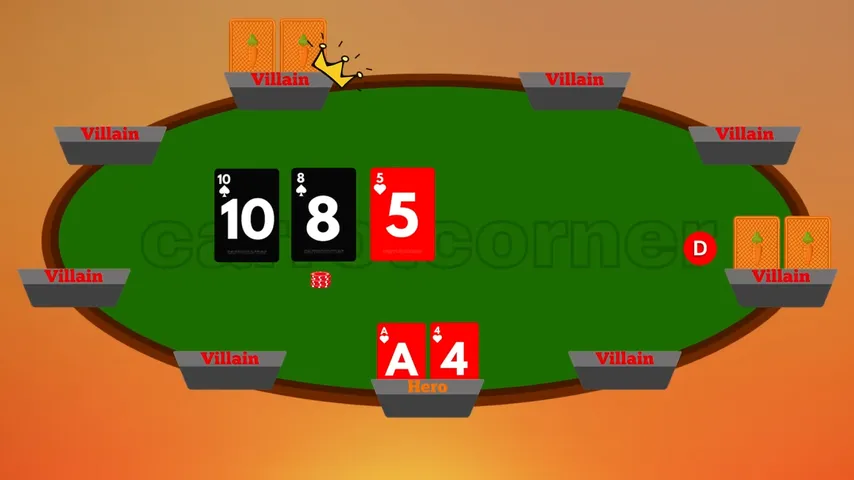
Suppose you check, the whale bets tiny, the aggro reg raises that small bet, and you have an overcard and backdoors.
This is an elite spot to attack. The whale’s donk bet is almost always capped and weak. The reg’s raise is often pure punishment — raising wide to isolate the whale and apply pressure. Both ranges are capped and wide here. When you 3-bet this donk bet–raise line, it puts maximum pressure on a reg who understands exactly what their range looks like. They’re raising the whale with tons of weak hands. They are not expecting the “third player” — you — to show up with a strong range or an aggressive counter-raise. So the play prints.
The same idea applies preflop. When the reg opens and the whale cold-calls the small blind, and you're in the big blind or straddle, you can squeeze wider than normal. Their ranges are stretched. Your squeeze picks up dead money from both the reg’s isolation attempts and the whale’s loose calling tendencies. The aggro reg’s EV comes largely from isolating bad players and playing inflated pots against them. You can parasitize that EV by attacking aggressively in the same direction — but with tighter structure, better hand-selection, and a stronger conceptual understanding.
And if you understand the spots where the aggro reg’s range has ballooned in size in order to isolate the recreational player more often, you’re going to find yourself with more fold equity than usual. You can value-bet thinner than usual. You can widen your range in multiple directions — preflop, flop, turn, and river — because their range is stretched, bloated, and full of hands that cannot withstand pressure. When they extend themselves to exploit the whale, you get to exploit them.




